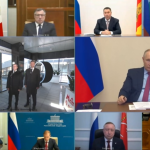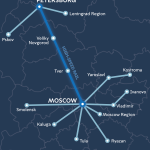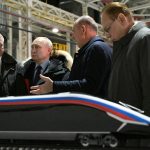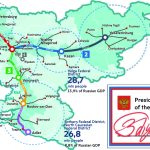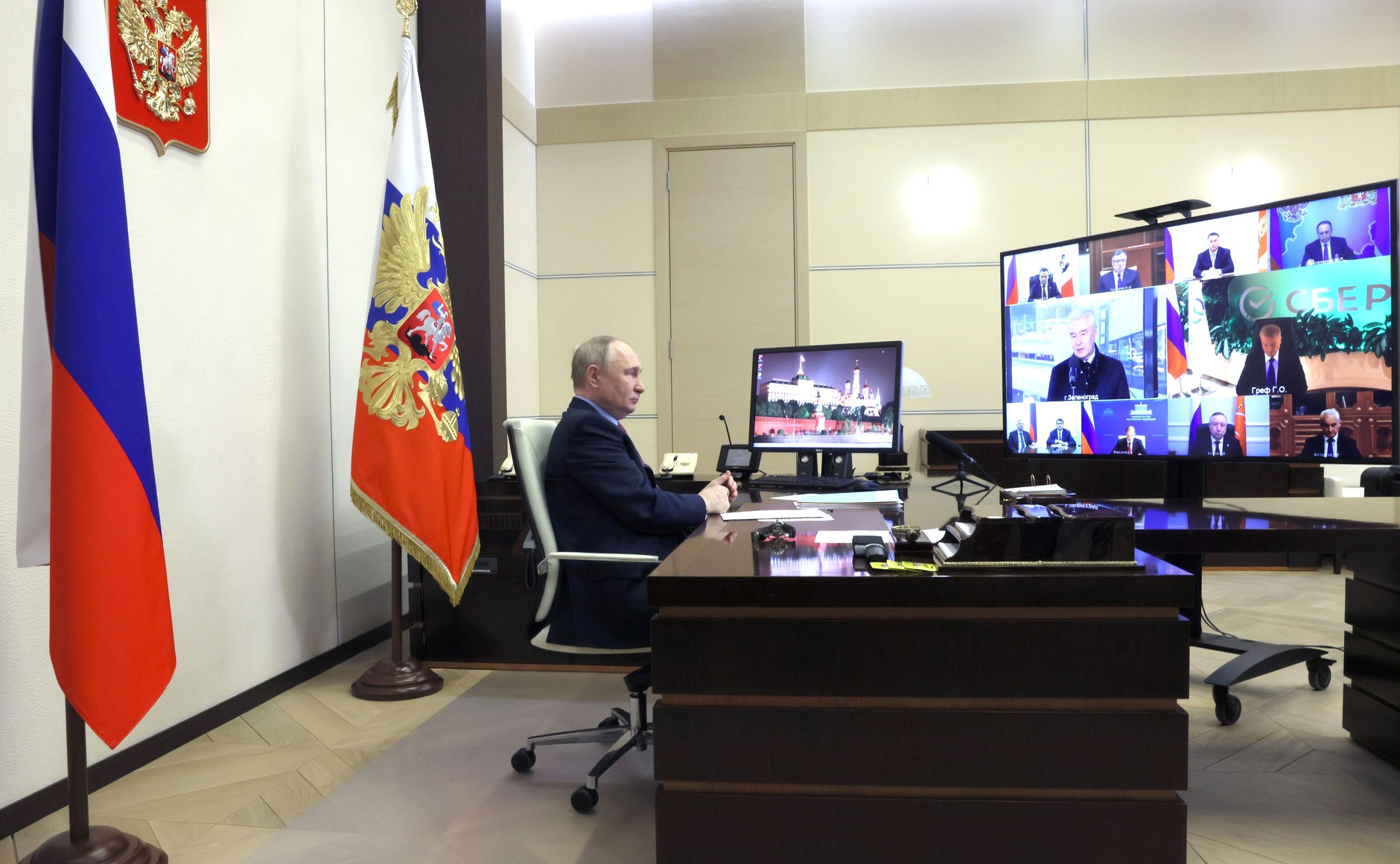 The President of Russia, Vladimir Putin, held a ceremony on March 14, via video conference to launch the construction of Moscow – St Petersburg high-speed railway that will cross through six regions with a population of about 30 million.
The President of Russia, Vladimir Putin, held a ceremony on March 14, via video conference to launch the construction of Moscow – St Petersburg high-speed railway that will cross through six regions with a population of about 30 million.
“The railway between Moscow and St Petersburg will become a flagship, starting stage in this respect. It will pass through six regions of the Federation with about 30 million people. This is around 20 percent of Russia’s entire population. In perspective, such dedicated high-speed routes will also connect other Russian regions and will facilitate the growth of tourism and business activity,” Vladimir Putin said.
The event was also attended, at Zelenograd station, by the Moscow Mayor, Sergey Sobyanin, the Minister of Transport, Vitaly Savelyev, the Director General of Russian Railways (RZD), Oleg Belozerov.
This is the first high-speed rail in Russia and will pass through the cities of Moscow and St Petersburg, Leningrad, Novgorod, Tver and Moscow regions. The ambitious project includes 16 stations along the route, with four strategically located within the capital.
Moscow – St Petersburg high-speed railway will cut travel time between the two cities to 2 hours and 15 minutes instead of 4 hours and the journey between Moscow and Tver will be reduced to 39 minutes, and between Veliky Novgorod and St. Petersburg with 29 minutes.
The new HSR line will have connection to the Moscow public transport system, providing increased access to such services and integrate heavy rail and urban rail transport. “I would like to note the great work being done by the Moscow Government and Russian Railways in the construction of the Central Transport Hub, the Moscow Central Diameters, which are an integral part of our Moscow – St Petersburg high-speed railway,” the Minister of Transport said.
The reduced travel time between Moscow and St. Petersburg signifies a revolutionary enhancement in connectivity, promoting regional development and economic growth. Forecasts suggest that by 2028, trains on the high-speed railway will run at intervals of 15-20 minutes during peak hours and 10-15 minutes starting from 2030. It is expected that the new line will transport 23 million passengers per year and will generate a massive increase in tourists’ number.
The construction of the line is the first phase of Russia’s high-speed rail network which will be built to deliver connections to Ryazan, Kazan, Yekaterinburg and Adler, with a possible connection to Minsk, in Belarus.
In Moscow, the project covers track expansion from Leningradsky Railway Station to Alabushevo, the construction of six bridges and five rail overpasses, the completion of the reconstruction of three highway overpasses, the modernisation of passenger facilities at nine stations to meet the standards of Moscow Central Diameters. According to the director general of Russian Railways, this year RUB 14 billion (USD 153.7 million) will be invested for the construction of a “unique bridge across Moscow Canal and on a number of large artificial structures”.
In addition, in Moscow, the project covers the reconstruction of four future high-speed rail stations, including Leningradsky station, Rizhskaya, Petrovsko-Razumovskaya, and Zelenograd-Kryukovo, facilitating transfers to 14 metro and MCD stations in addition to all ground public transport options.
In Moscow, at all key stations, state-of-the-art passenger infrastructure will be built.
“For Moscow and St. Petersburg, this is, of course, the most important road that will connect the two agglomerations, millions of people who very often travel from Moscow to St. Petersburg and back. This, of course, includes business activity, as you said, and tourism, it’s just a different quality of life and a different economy, which is important,” the Moscow Mayor said.
Regarding the financing pf the project, Herman Oskarovich Gref, the President Sberbank of Russia said that “we have collected an investment pool of RUB 1.5 trillion [USD 16.4 billion], funding for banking and pension funds. Almost all financing mechanisms [for the project] are ready, and we are ready to begin financing the construction of the line together with VEB using the mechanism of the Project Financing Factory already. This will allow the construction of the rail tracks.”
The construction of the new high-speed line will also provide increased capacity and speed for freight movement. It will allow RZD to increase the cargo volumes by additional 30 million tonnes generated by 18 regions of Russia.
Domestic industry involvement
The new railway line and rolling stock will be constructed by domestic companies. “The high-speed railway project implies large-scale production cooperation and the participation of many labour collectives and engineering teams. Hence, it will provide many branches of our economy with a good impetus for development. We will take one more step towards strengthening our national technological sovereignty,” the President of Russia said.
A key stage of this project will also be the creation of a domestic high-speed train. Recently, Vladimir Putin, together with the Minister of Industry and Trade, Denis Manturov, visited the Ural Locomotives, where a model of a high-speed train with eight cars has been presented, including finished products for rolling stock.
During the launching ceremony, the director general of RZD said that “a huge amount of work has already been done on high-speed rolling stock. The draft version of the train has already been finally selected and approved. This is an 8-car train that will travel at a maximum speed of 400 km/h and an operating speed of 360 km/h. This train can be doubled, from an 8-car or 16-car version, with four types of cars. Practically now design documentation is being carried out.”
Companies to be involved in the project includes Transmashholding (TMH), MTZ Transmash, United Metallurgical Company, Sinara Group, ТЕК-КОМ, Russian Electric Motors, and Evraz.
The Minister of Industry and Trade, Denis Manturov, said that following the visit to Ural Locomotives plant, “we further worked out the issue of manufacturing high-speed trains, sorted out all the cooperation and I confirm that the Sinara Group is most suitable for carrying out this task as the lead contractor.
In 2023, Sinara managed to replace the Lastochka EMU with the entirely Russian-made Finist train. By now, 16 Finist trains have been handed over to Russian Railways and six more are being prepared for delivery in the second quarter of this year. “The developed competencies and technologies allow Sinara to move into the segment of electric trains with speeds of up to 400 km/h. For this purpose, it is planned to build two new plants with a total area of 60,000 square meters at the Ural Locomotives site,” the Minister of Industry said.
Under the project, Transmashholding will also be involved and will provide the new trains with essential components and systems. In total, 100 Russian suppliers of raw materials, materials and components will take part in the project. The total investment for rolling stock is estimated at RUB 35 billion (USD 384.2 million) and Sinara “intends to raise up to 80 % of this amount through the preferential mechanism of the cluster investment platform, a financial tool which provides industrial business with long and cheap credit resources. Sinara already has experience working with this financial mechanism for the production of mainline and shunting locomotives in the Kaluga and Sverdlovsk regions.
“The industry, with the support of the state, is ready to begin working on providing Russian-made electric high-speed trains. And starting from 2027, Ural Locomotives will be able to produce about 100 railcars annually,” the Minister of Industry said.
“We are preparing an application for targeted funding within the framework of the cluster investment platform mechanism, and part of it goes through the Industrial Development Fund,” the director general of Sinara Transport Machines. We confirm the readiness of the Sinara Group to work in cooperation with more than 150 Russian enterprises such as Transmashholding, MTZ Transmash, Transpnevmatika, Evraz, TEK-COM,” Victor Lesh, said.
For the rolling stock project, in October MTZ Transmash has signed an agreement with Railway Transport Engineering Centre (a joint venture between RZD and Sinara Transport Machines), for the approval of the technical specifications for the design of the braking system, anti-skid protection and a separate passenger-type air distributor. On February 27, the technical specifications for the development of a microprocessor train braking control system were also submitted for approval.
“By February 2025, we will have the design documentation completely ready. And in August 2025, the initial tests of the high-speed train braking system will be completed. Accordingly, by August 2026, the certification of the braking system will be completed, and we will be ready for mass production together with Sinara,” the director general of MTZ Transmash, Nikolay Egorenkov, said.
Share on:





